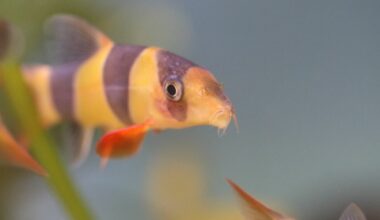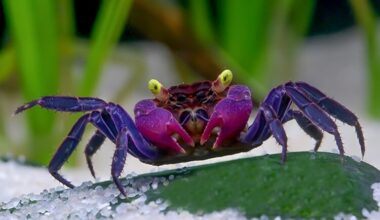Peppermint Shrimp can bring both beauty and practical benefits to your marine environment. In this guide, we will share our knowledge and insights to help you provide the best care for your Peppermint Shrimp.
We’ll explore their unique characteristics, preferred habitat, feeding habits, and the advantages they offer for maintaining a healthy aquarium. Whether you’re an experienced hobbyist or new to the world of saltwater tanks, we’re here to offer our expertise and assist you in creating a thriving and harmonious ecosystem for these delightful crustaceans.
So, let’s dive in and discover the wonderful world of Peppermint Shrimp together!
Table of Contents
Species Summary
Peppermint Shrimps, otherwise called Candy Cane Shrimps, Veined Shrimps or Caribbean Cleaner Shrimps, are popular ornamental invertebrates perfect for reef tanks. They’re commonly found in the East Atlantic Ocean, Caribbean Sea, Gulf of Mexico and along the coasts of Florida.
They live in the shallow coral reefs and near tube sponges where they’re most likely to find food. These shrimps were originally popular with hobbyists due to their striking red color but have since been found to be useful as cleaner shrimps. Peppermint Shrimp (Lysmata wurdemanni) will help you take better care of your tank by consuming pesky anemones, food debris, dead materials and more.
Many aquascapers in particular invest in Peppermint Shrimp to eliminate the local population of invasive Aiptasia, which can steal resources and sting fish. These saltwater invertebrates are relatively easy to find in stores and often only cost less than $10. They’re hardy, undemanding and most active at night.
Author Note: While these shrimp will rarely swim out in the open, their stunning color and markings give them an eye-catching profile you won’t want to miss.
Appearance
These brightly colored shrimp are semi-transparent and have a creamy-reddish exoskeleton. They’re lined with several red longitudinal lines and several slanted bands. The color of your Peppermint Shrimp can vary based on their health and stress levels.
Sick or anxious shrimp will turn almost completely transparent and will refuse to come out of hiding. The intensity and type of tank illumination can also have an impact on your shrimp’s concentration of body pigments.

Lifespan
Peppermint Shrimp have a lifespan of up to 2 years. If you’re not interested in breeding, it’s best to buy new young ones once your current shrimp begin showing signs of old age.
Average Size
An adult Peppermint Shrimp has an average size of 1.5 to 2 inches. Their antennae, which they use to search for food scraps and hiding places as well as to communicate, are often longer than their bodies.
Peppermint Shrimp Care
Peppermint Shrimps are beginner-friendly invertebrates that can adapt to a variety of water conditions. While these cleaner shrimp come with the added benefit of lessening your tank’s cleaning needs, they’re not completely self-sufficient.
To keep them as happy and healthy as possible, you’ll need to keep these few tank care requirements in mind.
Tank Size
The recommended tank size for a pair of Peppermint Shrimps is at least 10 gallons (check our 4 Best 10-Gallon Saltwater Tanks). If you’re investing in several, you should add five gallons for every additional shrimp. While these invertebrates are best suited to group environments, they can become aggressive or territorial if the tank is too small. Each shrimp needs enough space to claim a small cave or alcove as their own.
Water Parameters
Water temperature: 75°F to 82°F
pH levels: 8.1 to 8.4
Water hardness: 8 to 12 dKH
Specific gravity: 1.023 to 1.025
Tank Setup
Peppermint Shrimp thrive in tanks with plenty of hiding places and live stones. They don’t have any unique preferences concerning the substrate. While you don’t necessarily need a substrate for shrimp tanks, a few inches of gravel or sand will provide more living space for beneficial bacteria. You’re welcome to experiment with various habitat options like shell bottoms, tube sponges and rough shorelines.
Author Note: Live rocks are ideal as a biologically active surface can better trap food. They also offer plenty of exploration opportunities to keep your shrimp busy at night.
Consider using low-level lighting during the day, but be sure to turn it off completely in the evening. Peppermint Shrimps are prone to skittish hiding behaviors when frightened. Bright lighting can increase their stress levels, which will negatively impact their health over time.
It’s also important to note that because these invertebrates are so small, they can easily get sucked up by a strong filtration system. This is often only a concern in compact tanks where the shrimp regularly get close to the filter. Prevent any accidental deaths by placing a sponge or netting around the filter opening.
Are Peppermint Shrimps Reef-Safe?
Fortunately, Peppermint Shrimps are generally considered to be reef-safe invertebrates. Make sure not to mistake them for the destructive Atlantic Peppermint Shrimp that can strip several corals in just one night.
Peppermint Shrimps are peaceful and non-aggressive and shouldn’t have any issue coexisting with your fish or corals. However, in some situations, they have been found to nibble on and pick at the soft polyps of some coral species.
Common Possible Diseases & Prevention
In an ideal tank environment, you won’t have to worry about your hardy Peppermint Shrimp getting sick. They’re generally resistant to most illnesses, but they can be susceptible to common saltwater fish diseases like ammonia poisoning, marine ich, nitrite poisoning and dropsy. Regularly test your water and monitor your chemical levels to prevent any oxygen deprivation or harmful bacterial growth.
Peppermint Shrimp can’t tolerate excessive amounts of ammonia, copper or nitrate in the water. Make sure to regularly clean the tank and increase your aeration if your aquarium is overcrowded. Completing routine water testing as well as following quarantine procedures for new fish will keep your tank free of disease.
Food & Diet
Peppermint Shrimps are omnivores and get most of their food intake from searching the substrate and rocks for scraps. Some shrimps will even show an inclination toward eating the dead scales and bacteria off your fish. However, they won’t be able to survive solely on what they find. Ensure your shrimp are getting enough to eat by routinely providing sinking shrimp pellets, small fresh fish pieces or brine shrimp eggs.
Experts recommend adding an iodine supplement to the tank to help your shrimp regrow their exoskeleton. You should only administer iodine if you have the appropriate test kit. Too much of this chemical may lead to an overdose that harms your tank and causes excessive algae growth. Additionally, introducing carotenoids or astaxanthin into your shrimp’s diet could enhance their natural coloring, growth rate and chances of survival.
Behavior & Temperament
Like other shrimp species, Peppermint Shrimp will usually stick to the bottom of the tank near their chosen home. You’ll often spot them searching the rocks for detritus or sifting through the sandy substrate.
While they are considered a cleaner shrimp species, they’re not as efficient cleaners as other invertebrates like the skunk cleaner shrimp. It’s best to invest in several of these shrimps to ensure at least a few of them are interested in removing Aiptasia and other pesky debris.
They’re generally sociable and get along well with many other reef aquarium species. You won’t see them as much as your tank fish as they eat at night and stay out of sight during the day to hide from potential predators. Having several in the same tank can encourage them to be more active. If you haven’t seen your Peppermint Shrimp in a while, consider searching the tank with a flashlight equipped with a red filter.
Author Note: Don’t forget that Peppermint Shrimp need to molt as they grow. This occurrence becomes less frequent once they reach adulthood. As they are very vulnerable during this process, they’ll stay hidden for longer to avoid tank predators. Afterward, they’ll eat their discarded, nutrient-rich shell.

Peppermint Shrimp Tank Mates
Don’t put any fish or invertebrates bigger than six inches long in the tank with your Peppermint Shrimp. The larger the size difference, the more likely they’ll try to eat your shrimp.
You should avoid having any aggressive predators like Marine Bettas, Arrow Crabs, Dogface Pufferfish or Picasso Triggerfish. Other tank mates to stay away from include hawkfish, wrasse or Coral Banded Shrimp. There’s also the chance your shrimp may bully or pester some invertebrates like your tridacnid clams and hermit crabs.
You want to look for tank mates that are small, peaceful and herbivorous. You could even opt for omnivores or planktivores as long as they generally consider shrimp to be friends. Some great companions include filefish, tetras, dragonets and gobies. A few of the best tank mates for Peppermint Shrimp are:
- Yellow Tang
- Coral Beauty Dwarf Angelfish
- Pajama Cardinalfish
- Mandarin Goby
Breeding
Peppermint Shrimp are simultaneous hermaphrodites that will initially mature as males before they later develop female qualities. All adult shrimps of this species have both male and female reproductive organs. These shrimps typically live as functioning males before a molt but can lay eggs and take on the female role for a short period of time after shedding their old shells. Even if your shrimp does lay eggs, they won’t hatch unless there’s a male to fertilize them.
Author Note: While you shouldn’t have any issue getting your shrimps to mate, it’s a much harder task to keep the larvae alive after they hatch. The female will carry the blueish eggs under her abdomen for about 10 to 12 days until they turn a silver color.
When they hatch, the larvae will head toward the nearest light source. Use a lamp or flashlight to bait them toward the top and collect them with a gentle larval snagger before they’re eaten. Planktivorous fish and even adult shrimp are known to feast on these babies.
Place the larvae in a separate tank or rearing container free of any potential predators. It will take about 30 days for the babies to become juveniles. During this time, they should be fed foods like baby brine shrimp and copepods
Wrapping Up
We hope our Peppermint Shrimp care guide has provided you with valuable information and a deeper understanding of these captivating creatures. By now, you’ve learned how Peppermint Shrimp can not only enhance the beauty of your saltwater aquarium but also serve as helpful tank cleaners.
Remember to provide them with a suitable environment, including ample hiding spots and appropriate tank mates. Watching these shrimps as they go about their scavenging duties can be a truly mesmerizing experience. As you continue your journey in the world of marine aquaria, we encourage you to keep exploring and expanding your knowledge.
If you have any comments/questions don’t hesitate to reach out to us and feel free to tag us on Facebook when posting a cool photo of your tank. By the way, if you are looking to learn more about other fish check out our Saltwater Fish Care Guides.
Wishing you a successful and fulfilling shrimp-keeping adventure!

